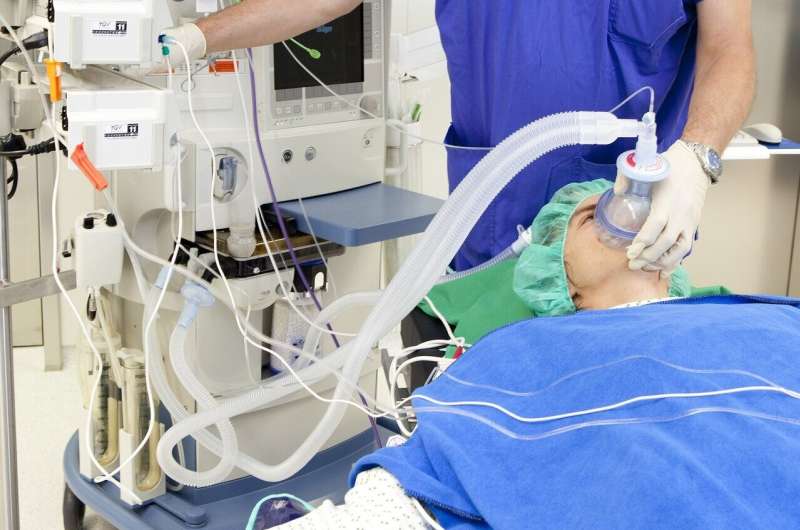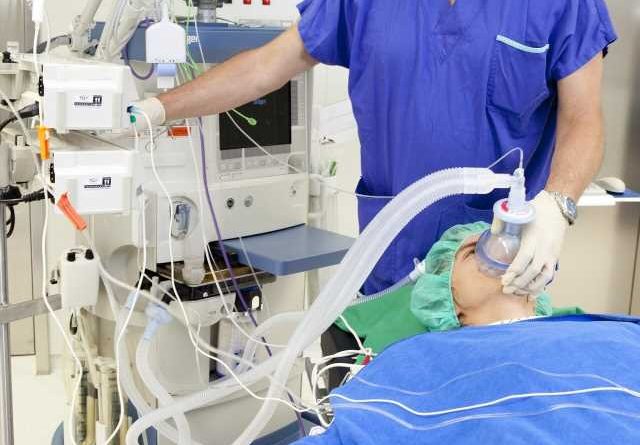Anesthesia found to block sensation by cutting off communication within the cortex

General anesthesia evokes a dual mystery: How does it disrupt consciousness, including sensory perception, and what might that say about the nature of consciousness? A new study led by researchers at The Picower Institute for Learning and Memory at MIT provides evidence in animals that consciousness depends on properly synchronized communication across the brain’s cortex and that the anesthetic drug Propofol cancels sensory processing by cutting it off.
In the Journal of Cognitive Neuroscience, researchers report clear evidence that in anesthetized animals, sounds and tactile sensations still produce neural activity in an area of the cortex that receives incoming sensory information. But just as clearly, measurements of neural spiking and broader oscillatory activity showed that those signals failed to propagate to three other cortical regions with higher-level processing and cognitive responsibilities, as seen during normal wakefulness.
“What this study shows is that the cortex isn’t getting on the same page,” said study corresponding author Earl K. Miller, Picower Professor in the Department of Brain and Cognitive Sciences at MIT. “Information is making it to the cortex. It’s being registered in primary sensory areas. It’s just not reaching the rest of the cortex. Because of the anesthesia, it only makes it part of the way through.”
The significance of that, said co-senior author Emery N. Brown, Edward Hood Taplin Professor of Medical Engineering and Computational Neuroscience, is that “the study suggests that consciousness requires coordination of activities among cortical regions. Simply activating one or more of these regions is not sufficient.”
Study lead author John Tauber, who recently earned his Ph.D. at MIT in Brown’s lab, said the study could aid efforts to improve anesthesiology care. Brown is an anesthesiologist at Massachusetts General Hospital as well as an MIT professor of Brain and Cognitive Sciences, a member of the Institute for Medical Engineering and Science, and a faculty member of Harvard Medical School.
“We hope our paper further highlights the importance of actively monitoring what is happening in the brain during anesthesia,” Tauber said. “Future studies in this direction will help us develop clear indicators of whether a patient is still processing sensory information. This would allow anesthesiologists to adjust drug dosage and prevent intraoperative awareness from occurring.”
Stymied sensory processing
To conduct the study the team worked with two animal subjects to measure brain activity—both the electrical “spiking” of individual neurons and their collective rhythmic activity—via electrode arrays placed in four areas of the cortex both before and after they underwent propofol general anesthesia.
The researchers selected the areas of the cortex to represent its hierarchical continuum of functions from initial sensation (the superior temporal gyrus, or STG) to increasingly high levels of cognition (the posterior parietal cortex, or PPC; Region 8A; and the prefrontal cortex, or PFC).
During both states of consciousness, the animals experienced specific stimulations: two audio tones, including one on its own and another paired with a puff of air on the face. In the awake state, such stimulation produced an increase in all cortical areas for alpha/beta frequency activity. STG also showed a strong increase in higher frequency oscillations. The response changed dramatically under anesthesia. While the alpha and beta frequency response was diminished in STG, it virtually vanished in all the higher cortical regions.
“We expected to see a more gradual loss of responses and information,” Tauber said. “The drop-off in responses during anesthesia from auditory cortex (STG) to associative cortex (PPC) was striking.”
Along with the decrease in activity, the researchers measured a decrease in the sensory information detectable in the brain as they moved up the cortical hierarchy. “Decoder” software found sensory information in all areas of the cortex during the awake state but during unconsciousness, less and less information could be found the higher up the cortex the researchers looked.
An incoherent cortex
When the researchers next measured the synchronization of activity among brain regions, they found that it, too, broke down under anesthesia. When animals were awake, they exhibited a strong degree of synchronization in alpha/beta oscillation activity but when unconscious, “there was little or no stimulus-induced synchronization for any of the pairs of cortical areas,” the researchers reported.
A feature of the propofol-anesthetized brain is that neural oscillation activity takes on distinct “up” and “down” states of greater or lesser activity over time. To test whether sensory information is cut off during both states or just the down states, the researchers developed a statistical analysis. They found that while all neuronal spiking was indeed low during the down states, even during up states when sensory signals were measurable in STG they still failed to go beyond that region.
“We expected responses in the higher cortical areas to at least be disrupted during up states, but it was a bit surprising to find the responses disappeared almost entirely,” Tauber said. “The neural activity during up states is functionally quite different from the awake state, but we think we have just scratched the surface in understanding the differences between the two.”
In sum, the evidence in the new study shows that unconsciousness doesn’t arise from a wholesale shutting down of the cortex, as much as a suppression of communication within it, Miller said.
A key next question to answer is how propofol enforces that suppression.
“What is it about these changing dynamics that block the flow of information through the cortex?” Miller asks. “What’s the headwind that’s blowing back that sensory information and keeping it in the sensory cortex?”
Tauber added that the team looked at sensory processing only when they were certain the animals were fully unconscious. It could be informative, he said, to study how sensory processing changes during the transition from wakefulness to that fully unconscious state.
More information:
John M. Tauber et al, Propofol-mediated Unconsciousness Disrupts Progression of Sensory Signals through the Cortical Hierarchy, Journal of Cognitive Neuroscience (2023). DOI: 10.1162/jocn_a_02081
Journal information:
Journal of Cognitive Neuroscience
Source: Read Full Article



